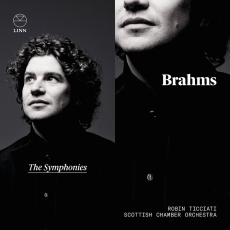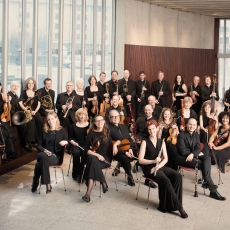Robin Ticciati & SCO - Brahms: The Symphonies - Fanfare
Theoretically, HIP Brahms has a greater chance of sounding authentic than music from earlier eras. The Baroque is lost in historical silence, which is why, after all the musicological delving, one finds that period performance styles on disc are a mish-mash. No two recordings of major masterpieces agree on basic things like tempo and instrumentation. On the other hand, music of the high Romantic period like the Brahms symphonies gave rise to performance styles that came down to us through living conductors and orchestras, with ample evidence on early recordings. But there’s the rub. Weingartner, Nikisch, Bruno Walter, Toscanini, and Furtwängler are individualists, not cut-outs representing a fixed tradition (I imagine the great 18th-century performers weren’t carbon copies of HIP dogma, either).
In general I’ve found period Brahms fairly ghastly (John Eliot Gardiner, Roger Norrington), improving as the conductors improve (Thomas Dausgaard, Philippe Herreweghe), and now reaching some sort of culmination in Robin Ticciati. What sets the onetime Wunderkind, now 35, apart is his flexible, personal response to Brahms, along with his opera experience—as the head of Glyndebourne Opera since 2014, he has conducted a work like Der Rosenkavalier in the right, sumptuous late-Romantic style. There’s no question of squeezing Brahms through a Baroque sieve. In fact, the main thing Ticciati’s Brahms has going for it is the conductor’s musical instincts for how the symphonies should go. Authenticity comes second.
In a booklet note Ticciati makes clear that he and the Scottish Chamber Orchestra worked and thought together about HIP Brahms; the recording sessions spanned two weeks in 2017. The stylistic elements they weighed, he says, were “details of wind articulation, string portamenti, the notion of vibrato as ornament, [and] tempo rubato.” The overall plan, however, was to turn the tables on Brahms’s critics in his lifetime who complained that his symphonies were chamber music pumped up on a large scale. Ticciati aims to make them sound intentionally like chamber music.
Fortunately, this potentially perverse idea is carried out by an orchestra not far from the size of the Meiningen court orchestra that is often cited as Brahms’s favorite (a skewed piece of evidence since he was also thrilled by having the Vienna Philharmonic play the Fourth Symphony with 18 first violins). Here the strings are a healthy 10-8-6-6-4, so there’s no risk that they will sound like a Baroque trio sonata. The chief deficit, for me, is that when vibrato is totally absent, the violin sound from a chamber orchestra is too thin, and correspondingly the woodwinds and brass aren’t sufficiently cushioned. In that regard, Ticciati says he wanted a raw, bright brass sound, so narrow-bore trombones and late-19th century horns are in use.
Surely the oddest decisions concern portamento, which appears randomly, so far as I can tell, and goes both up and down. A downward portamento reminds me of a penny whistle in old Hollywood comedies when someone slips on a banana peel. The effect is about the same in Brahms, but these gestures occur infrequently here. The good news is that overall these performances feel not only Brahmsian but also full of color and variety.
Ticciati doesn’t mistake a pared-down orchestra for pared-down expression. In a touchstone passage like the slow introduction to the finale of Symphony No. 1, there is all the premonition and weight the passage demands. In the quiet statement of the theme that begins the finale of the Second Symphony, hushed expectation is achieved before the burst of sunlight when the theme leaps into forte. Tempos are almost always standard, and in particular the slow movements aren’t arbitrarily sped up as if we’re dealing with Beethoven’s metronome. The use of rubato is generous, so we aren’t at the Weingartner-Toscanini end of the spectrum.
Linn’s recorded sound from Usher Hall in Edinburgh is clean and clear but nothing exceptional. The timpani is prominent, which adds to the sense of momentum. There are occasional imbalances. The first movement of the Third is overly dominated by the brass at the expense of the violins; the triangle in the Scherzo of the Fourth is very recessive when it should be prominent.
Since I am skeptical about authenticity, I won’t recommend this new set of Brahms symphonies on the basis of historical factualness. It wins favor by being so musical and involving, which is not very common in HIP Brahms. For anyone who considers Bernstein, Karajan, Giulini, and Klemperer too throbbing and monolithic, Ticciati’s approach may hold considerable appeal.


